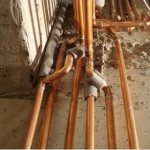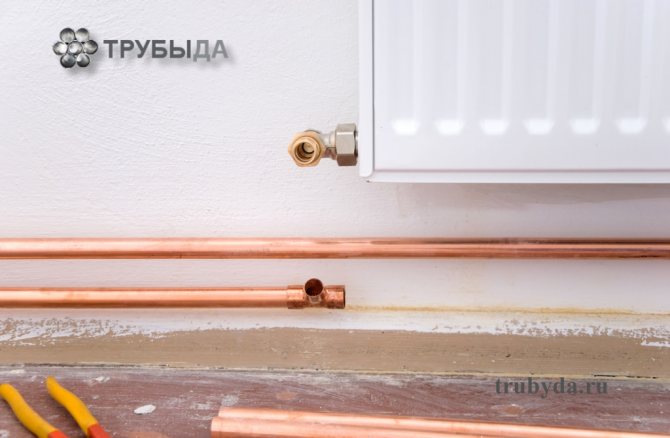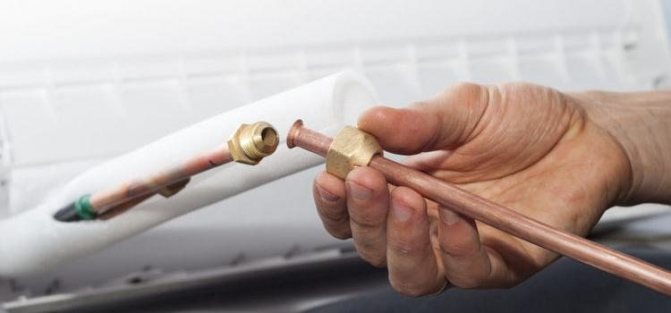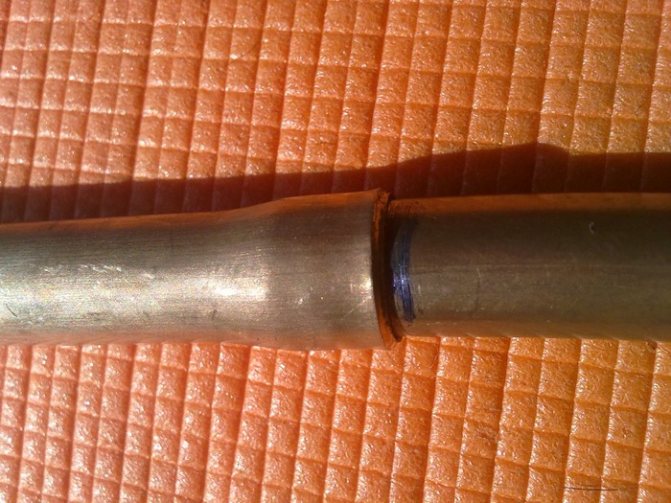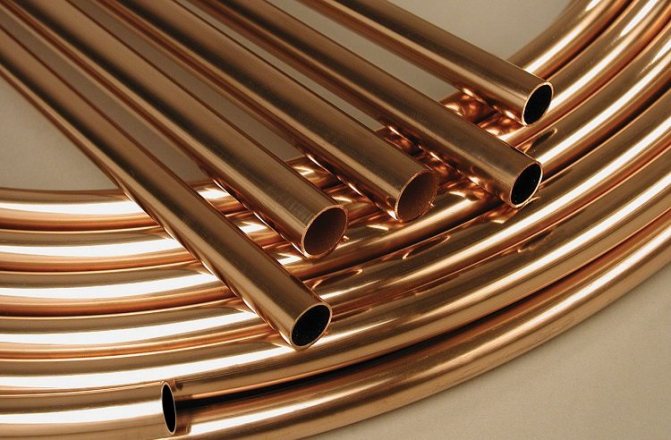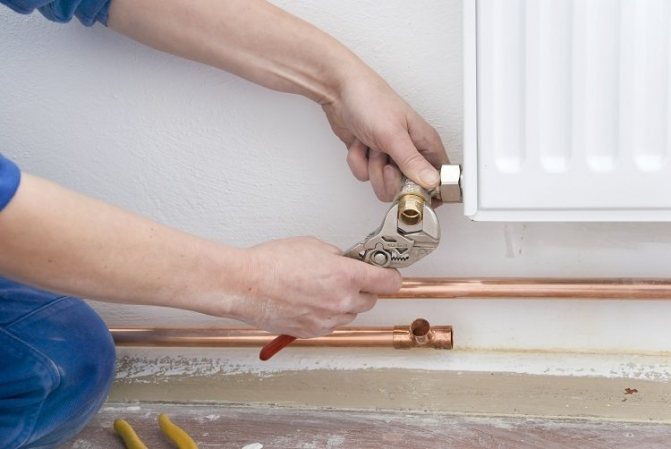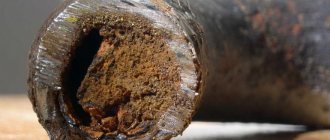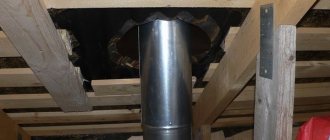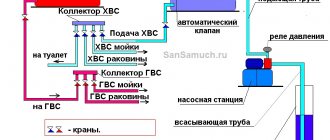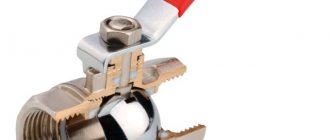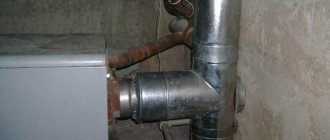Applications
There are several situations when it is better to choose this material:
- The current option for installing a heating system made of copper pipes is to connect to a solid fuel boiler. This is due to the fact that such systems are exposed to prolonged exposure to high temperatures (over 100 degrees Celsius).
- Compared to other materials, copper is better if it has a complex shape.
- Installation will be 100% justified if the owner of the house has enough funds, he wants to get the highest indicator of durability.
When considering other options, you need to pay attention to plastic or stainless steel.
Copper pipe for water supply and heating. Specifications.
Nowadays, copper pipes are not so common, since copper is an expensive material. They are used in piping systems, air conditioning, heating, automotive engineering, etc. Such pipes have many advantages over conventional steel and cast iron pipelines:
— resistant to temperature changes (copper pipes can operate in extreme temperatures from -200 to + 200 ° C);
— good plasticity (this is a very necessary indicator, especially when the installation or installation conditions are difficult);
— corrosion resistance (extends the service life of the pipeline);
- reliability (good strength and ability to withstand relatively high pressure drops).
Copper pipes are excellent heat conductor 400 W / (m · C), therefore they are used for the production of heat exchange equipment, evaporators, condensers. They have good performance characteristics during installation and assembly. Withstand pressure drops up to 200 atmospheres.
Copper pipes can last about 50 years. They are used for domestic piping as they have good infectious protection (prevent germs from multiplying), high practicality and reliability... And the most important thing is that they have good appearance, which is also important.
For a better aesthetic appearance, copper pipes are chrome plated.
Unlike modern plastic pipes, they have more high throughput due to lower indicators of surface roughness.
GOST 617 copper pipes.
Copper pipes must comply with the characteristics of GOST 617-2006, the last updates and adjustments to this GOST were in 2006.
Disadvantages.
The disadvantages of copper pipes are their cost and a higher material density than conventional steel pipes. The cost is formed from the costs of production and the materials used. The main expensive component is copper, which mainly determines the price of pipes. Due to the density of copper - 8920 kg / m3 versus steel - 7800 kg / m3, its weight is slightly higher, however, all these shortcomings are compensated by the service life of these pipes.
Copper pipe production.
Pipes are made by rolling and pressing. The shape of the longitudinal section can be round, square and others, depending on the needs of the customer. Copper pipes of a circular cross-section are made by rolling and pressing, in contrast to square ones. They are made only by pressing with subsequent seam welding.
After rolling or pressing, depending on the type, the pipe can be thermally processed, this is called annealing.
Types of copper pipes.
I would like to note about the classification of copper pipes. According to the manufacturing method, two types are distinguished: annealed and unannealed.
The annealed type of pipes differs from the unannealed ones by special heat treatment. They are placed in an oven and heated to 700 ° C, after which they are gradually cooled. Subsequently, the pipes become more plastic and softer.
Unannealed pipes have characteristics of high breaking strength, which is about 450 MPa. True, unlike annealed pipes, it does not have such plasticity.
It is not easy to find a good copper pipe manufacturer to match the quality - price. Moreover, now there are not many companies producing such pipes. It all depends on the supply of quality material from which pipes will be subsequently made.
Types
In specialized stores, you can find a large number of copper elements intended for the manufacture of heating systems. They are divided according to different factors:
- The material from which the pipeline elements are made. It can be pure copper, tin alloy, zinc alloy.
- Seamless or welded.
- Pressed or drawn.
- Non-insulated, plastic coated.
Plastic-coated copper pipes are protected from physical impact, damage. In addition to this, the rate of heat loss decreases, and the efficiency of the system increases.
For water supply
Pipes made of copper have been used since ancient times. Such products came to European countries along with America in the middle of the twentieth century. Acquaintance with these details happened at the beginning of the last century.
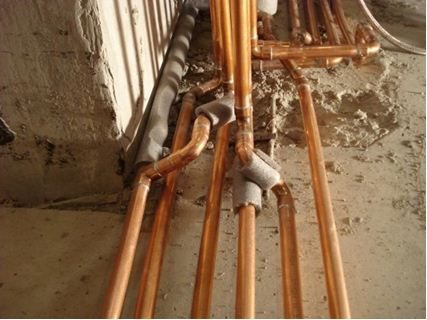
Wear resistance
The long service life of copper pipes is the main indisputable advantage of such products over other pipes for water supply made of different materials. Manufacturers of copper parts roughly determined the maximum service life of such labor, which was 100 years or more, which means, based on the average life expectancy of people, forever.
Endurance to temperature extremes
Copper melts at a temperature of 1084 ° C. At the same time, pipelines for supplying water from copper are designed for operation at a maximum temperature of 2500C. Due to the low melting point of the solder used to join copper pipe parts. Even with fusible solder, the temperature of use of copper piping, equal to 250 degrees, is quite high compared to the limiting temperatures of other non-metallic materials. This temperature limit is sufficient to maintain the stability of copper products at any temperature of the carrier at the outlet from the boiler. For example, the maximum temperature for using polypropylene pipes is 950C.


Labeling and cost
Pipes for heating are manufactured and marked according to GOSTs. For example, products with a wall thickness of 0.8–10 mm are manufactured in accordance with GOST 617-90 standards. Another designation refers to the purity of copper, regulated by GOST 859-2001. In this case, the marks M1, M1p, M2, M2p, M3, M3 are allowed.
According to the marking that is indicated on the manufactured products, you can find out the following information:
- Cross-sectional shape. Designated by the letters KR.
- Length - this indicator has different markings. BT - bay, MD - dimensional, CD - multiple dimension.
- A method of manufacturing a product. If the element is welded, the letter C is indicated on it. On drawn products, the letter D.
- Special operational features. For example, increased technical characteristics are indicated by the letter P. High plasticity - PP, increased cut accuracy - PU, accuracy - PS, strength - PT.
- Manufacturing precision. The standard indicator is indicated by the letter H, the increased one is P.
To visually understand how to read the marking, you need to deal with a simple example - ДКРНМ50х3.0х3100. Decoding:
- It is made of pure copper, designated by the M1 brand.
- The product is stretched.
- The shape is round.
- Soft.
- The outer diameter is 50 mm.
- Wall thickness - 3 mm.
- Product length - 3100 mm.
European manufacturers use a special marking system DIN 1412. They put the designation EN-1057 on the elements of water supply and heating systems. It includes the number of the standard by which the pipes are manufactured, an additional element included in the composition - phosphorus. It is needed to increase resistance to rust.
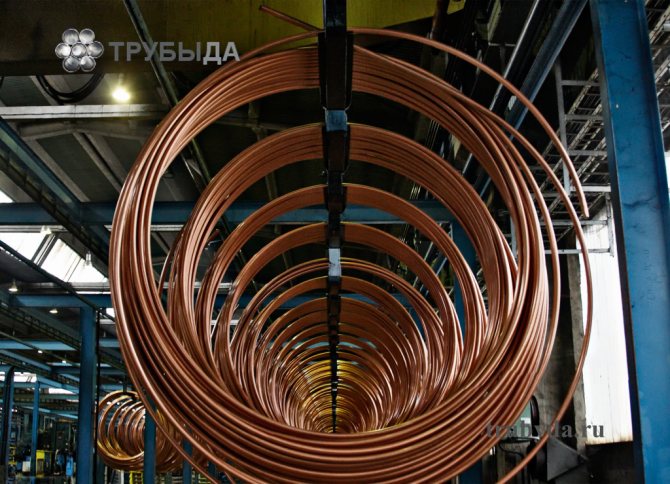

Copper pipes in the factory
Tips for choosing copper pipes
In order to make the right choice of copper pipes for the heating system, certain parameters must be taken into account: 1. The density of the pipes. It is better to choose pipes with a lower density, since they are light in weight and are more convenient for transportation and installation. 2. Low coefficient of thermal conductivity. An important indicator, guided by which you can find out how quickly heat loss occurs. 3. The temperature at which the pipes melt. Focusing on this temperature, you can take into account the temperature of the water that will circulate through these pipes. 4. The inner surface of the pipes. It should be smooth, without pores, so as not to trap dirt. Copper pipes are perfectly smooth and even inside. 5. Expansion of the pipe under the influence of high temperatures. This indicator allows you to determine how much the pipe size will increase when heated.
Advantages and disadvantages of copper pipes
The copper elements that are used for the manufacture of heating systems have strengths and weaknesses. Benefits:
- The service life is up to 50 years.
- Withstand pressure over 30 atmospheres.
- The material does not react to ultraviolet light, it is resistant to corrosion in natural conditions.
- No air leaks through the walls.
- Copper does not emit harmful substances. Possesses antibacterial properties.
- Light weight.
- It is possible to defrost the system 3 times.
- The material withstands prolonged exposure to active chemicals, does not emit any additional elements.
- Deposits do not accumulate on the inner surface of the products.
- Low rate of thermal expansion, no expansion joints required.
Disadvantages:
- High price when compared to other materials.
- The connections are one-piece, because of this, difficulties may arise during installation.
- Electrochemical corrosion can occur if you try to combine copper with other metals.
- If the room is with a high level of humidity, corrosion may appear on the surface of the products.
- A high rate of electrical conductivity contributes to the deterioration of the condition of the walls of the products.
- To reduce heat loss in the walls, it is necessary to use additional insulation.
Basic properties of copper
Copper is a versatile material that is used in a variety of applications. When using pipes for heating among other metals copper is distinguished by the following properties:
1. Durability and long service life. Copper does not corrode. Copper products often have a lifespan of about 100 years. 2. Protection against bacteria. In ancient times, copper was used for the manufacture of drinking vessels precisely because it has bactericidal properties, prevents the growth of microbes, and is resistant to moisture and air. 3. Ability to withstand high and low temperatures and strong pressure.
Methods for connecting copper pipes
Copper pipelines are reliable, durable, resistant to physical stress and corrosion. However, they can boast of such properties only with proper assembly. To combine individual elements into one system, there are several methods:
- Compression fittings.These are special elements used to connect copper pipelines: push-in fittings, crosses, bends, couplings. They are made of bronze, brass, copper.
- One-piece connection method. This is a pressing technology that is carried out using press fittings, crimp sleeves. The strength of the finished joint is comparable to the soldering method.
- Compression connection. It is detachable, with high strength. For work, you need hand tools, special collet clamps. However, this type of connection weakens over time from pressure surges, temperature drops. It is important to monitor it, periodically change consumables.
- Soldering using copper fittings. A special element is used, which is called capillary. Solder is needed to create a secure connection.
It is important that after soldering the products cool under natural conditions.
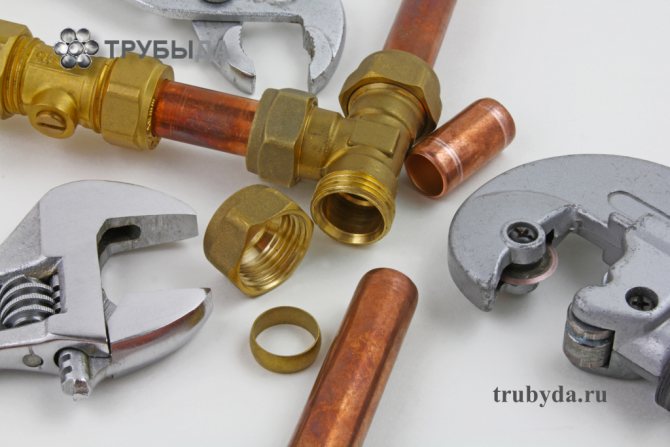

Compression fittings for connecting pipes
Stage three. Joint cooling
When the brazing of the copper pipe is complete, the joint must be cooled. To do this, you can either simply leave the pipe and let it cool on its own, or use water.
After that, it remains to assemble the heating system. This will not be difficult at all, since the fittings can be connected together without any effort.
Thus, the installation of a heating system made of copper pipes is not the most difficult task that can be solved on our own. Therefore, by spending money on copper pipes, you can easily save on installation work, and then for a long time, subject to quality installation, enjoy all the advantages of the heating system.
Installation of copper heating pipes
The most reliable, popular way of installing copper heating pipes is brazing. Step-by-step instructions for performing work:
- Cut off part of the product to the desired length.
- Chamfer the inner diameter.
- Clean the outside of the pipe, the inside of the connecting piece (fitting). To do this, you need to use a synthetic brush.
- To create a reliable connection, it is required to cover the treated surfaces with a layer of flux.
- Ignite the gas burner, slowly heat up the parts to be connected.
- Heat surfaces until the flux melts.
- When the flux is liquid, take the soft solder that is sold in bars and place it where you want the seam to form.
- Gradually, the wire will melt, begin to spread along the joint, filling the free space.
Wait until the seam is formed along the entire joint without voids, wait for the finished joint to cool.
Benefits of using copper pipes in the heating system
Do not think that during the installation of the heating system, copper pipes are used only by virtue of the established tradition. Pipes made of this material have a number of undeniable advantages.
First of all, copper is a harmless material. In terms of its environmental friendliness, it bypasses many other materials, and only polymer pipes, for example, reinforced polypropylene pipes, which are also used to equip heating systems, can compete with it.
Do not forget that copper has bactericidal properties.
Secondly, copper pipes for heating serve for a long time. Over time, they do not lose their performance properties and do not age. In total, copper pipes can function smoothly for exactly the same as the building in which they are installed.
Thirdly, it is worth noting such technical indicators as resistance to corrosion, ultraviolet radiation, high and low temperatures (from minus two hundred to plus three and a half thousand degrees Celsius). When subjected to high loads, copper pipes remain externally unchanged, which is of great importance for the implementation of heating projects in both residential and non-residential buildings.
Note that the corrosion resistance of copper pipes is ensured by the immunity of copper to chlorinated water. This property becomes defining when it comes to the installation of heating systems in apartment buildings.
Fourthly, copper has a high thermal conductivity. Thanks to this, the level of heat transfer and the efficiency of the entire heating system are significantly increased, and the room heats up much faster. Due to this, energy consumption will be reduced and it will be possible to save on energy resources.
How to paint copper heating pipes?
To paint a copper product, you can use several types of paint:
- Alkyd enamel. Resistant to high temperatures, physical influences.
- Acrylic paint. Manufactured on the basis of organic solvents.
- Coloring composition on a water-dispersion basis. Dries quickly, but stays on the surface for a short period of time.
It is easy to paint on metal substrates. Its service life directly depends on the chosen coloring composition, the average durability is about 5 years. To increase adhesion, the metal must be cleaned with fine sandpaper.
Copper pipes are rarely used to make pipelines. This is due to their high price. If there are enough funds, this is the best option for durability and reliability. It is important to correctly choose the type of connection of individual elements so that the system will serve as long as possible.
Insulated Copper Products
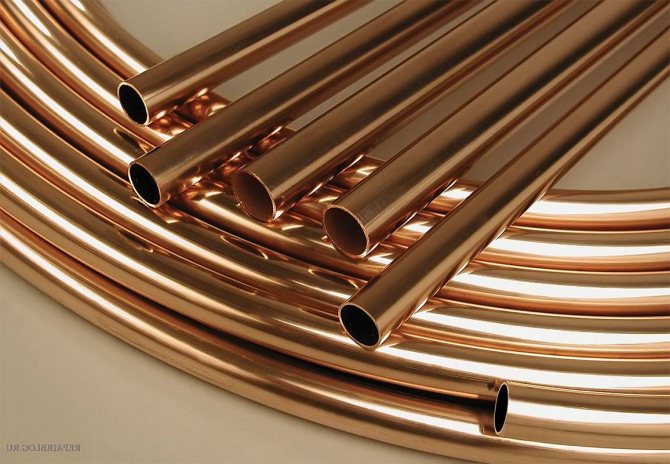

Among other things, copper pipes can have an additional insulating layer. Depending on this, they are divided into several types:
- Products with foam insulation based on rubber, polyurethane foam and polyethylene foam. Such pipes are used to reduce heat loss in heating and hot water systems. The thickness of the insulating layer will burn up to 3 cm.
- Copper pipes with polyethylene coating, the thickness of which reaches 2.5 mm. Products often have a diameter of 12 - 54 mm. They are often used in heating and cold water supply systems.
- Products with polyethylene insulation up to 3 mm thick. Pipes are laid with a hidden method in a monolithic structure. The product has design features that allow you to maintain the integrity of the pipeline during temperature fluctuations.
Copper pipes are not corrosive. Therefore, there is no need to apply a protective layer. But, as for additional insulation, it will not be superfluous, especially when it comes to the construction of a heating and water supply system. Especially often, such pipes are used for laying external networks that are subject to severe stress under the influence of the external environment.
